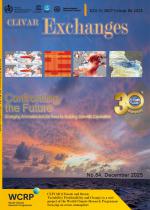Call for Contributions to Special Collection on “The Earth’s energy imbalance and its implications”

The organizers would like to invite you to contribute to a Special Collection titled “The Earth’s energy imbalance and its implications”, that will appear in the Journal of Climate and all other journals of the American Meteorological Society. Articles for the special collection should consider observations and/or modelling of all aspects of Earth’s energy imbalance and the resultant heating of various components of the Earth system (ocean, land, atmosphere and cryosphere). Please find below an overview of the special collection and practical information on the submission and publication process.
Overview: Climate change poses a major threat to our livelihoods, economy, and ecological treasures. On a range of timescales, climate processes are controlled by energy exchanges within and among the different components of the Earth system. Monitoring these energy flows, and the global net accumulation of energy as a result of radiative forcing, is essential to advance our understanding of climate variability and change, and for developing reliable future predictions.
Anthropogenic radiative forcing of the climate system has given rise to a radiative flux imbalance at the top-of-atmosphere (TOA), referred to as Earth’s energy imbalance (EEI). Observing EEI is fundamental in determining the rate of climate change at a global scale. To date, the most reliable approach to estimate the absolute magnitude of EEI is through assessing changes in heat storage across all relevant Earth system components. Due to the dominant role of the oceans in Earth’s heat budget, EEI can be reliably estimated from changes in ocean heat content on annual and longer timescales, while satellite observations of TOA net radiative flux variability can provide information at shorter timescales. However, a complete understanding of Earth’s energy flows, particularly on sub-annual timescales, requires improved estimates of change in all system components storing heat: the ocean including the deep ocean; the land surface; the atmosphere; and the cryosphere. Regional energy exchange through the atmosphere-surface boundary, horizontal energy transport by the atmosphere and ocean, and diabatic heating by radiation and precipitation are also essential elements of Earth’s energy flows.
The World Climate Research Programme (WCRP) has identified the improved quantification and understanding of global mean EEI and its spatial and temporal variability to be major challenges in climate research across disciplines. To address these challenges, we invite contributions that improve estimates of EEI and energy uptake across all relevant disciplines and Earth system components, exploiting in-situ measurements, reanalysis, climate modeling, and remote sensing techniques. A particular interest is the discussion of uncertainty associated with measurement and retrieval errors, and assumptions in algorithms. Papers discussing results of inter-comparison studies that identify and quantify biases are encouraged. We also solicit studies on the spatial and temporal variability of global and regional energy budgets at the TOA, the surface and within the atmosphere and studies that improve our understanding of processes that perturb energy budgets and energy flows on various spatial and time scales. Furthermore, we invite authors to consider implications on key impact metrics of climate variability and change, such as sea level, the hydrological cycle, and regional climate extremes.
This special collection arose out of discussions at the WCRP workshop held in Toulouse during November 2018 and the workshop website may provide further useful context for authors:
www.clivar.org/events/2018-wcrp-workshop-earth%E2%80%99s-energy-imbalance-and-its-implications-eei
Authors are reminded that the IPCC AR6 has a deadline of 31st December 2019 for papers to be eligible for citation in the Working Group I report, but the collection itself will continue to accept submissions during 2020.
Practical information for potential authors:
Special collection papers are submitted, reviewed, and published following the same requirements and standards as other papers submitted to AMS publications. The peer review process for each paper will be handled by a regular journal editor, assigned by the journal's chief editor. Each special collection paper moves through peer review individually, and final decisions are given when the paper is ready (ie, decision times don't depend on other papers in the collection). Once accepted for publication, the same applies: each paper moves through editing, proofs, and final publication individually, and none are delayed due to other papers in the collection. Each special collection paper is assigned to regular monthly issue, and will appear online as part of a regular monthly issue. At the same time, a graphic logo on the title page identifies the paper as part of a particular special collection, and all papers in a special collection are linked to the collection's web page.
Authors wishing to find out more about the AMS submission process and requirements can go here. This page here lists the links for submitting to specific AMS journals and BAMS. To include your paper in the collection "The Earth's energy imbalance and its implications", begin the submission process in any AMS journal - you will be given the opportunity to select the collection once you have uploaded your manuscript and figure files.
If you already have a submission in review or recently published that you think would be a good fit for the collection, please contact the collection organizers.
Maria Hakuba, Matt Palmer, Seiji Kato, organizers of the special collection.











Add new comment